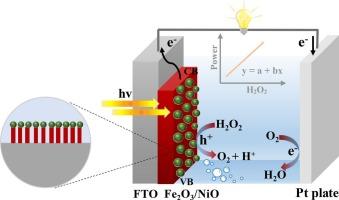基于Fe2O3/NiO光阳极的自供电传感器的构建及其在过氧化氢检测和太阳能发电中的应用
IF 4.1
3区 化学
Q1 CHEMISTRY, ANALYTICAL
引用次数: 0
摘要
光电化学(PEC)传感器具有潜在的高灵敏度、设备简单、操作方便、成本低等优点,是一种先进的分析方法。本文设计了以NiO修饰赤铁矿(α-Fe2O3)纳米棒光阳极为工作电极的三电极PEC传感器,该器件对0.01 ~ 1.2 mM范围内过氧化氢(H2O2)的检测灵敏度为678.88 μA cm−2 mM−1,线性相关系数分别为0.997。此外,PEC传感器还具有稳定性好、抗干扰性强、测定H2O2的实际应用能力。此外,采用Fe2O3/NiO和Pt片组成的双电极系统制作了自供电传感器,该传感器在没有外部电输入的情况下,最大产电为110.0 μW cm−2,对H2O2分析物的检测灵敏度为36.19 μW cm−2 mM−1。与纯fe2o3传感器相比,传感器对H2O2的传感性能提高了2倍;这是因为在Fe2O3表面修饰NiO可以抑制光生载流子复合,提高电荷分离效率,加快表面催化H2O2氧化动力学。本文章由计算机程序翻译,如有差异,请以英文原文为准。

Construction of self-powered sensor based on Fe2O3/NiO photoanode for hydroperoxide detection and solar electricity production
Photoelectrochemical (PEC) sensor has been developed as an advanced analysis on account of the merits of potential high sensitivity, simple equipment, easy operation and low cost. Herein, a three-electrode PEC sensor is designed by applying NiO modified hematite (α-Fe2O3) nanorod photoanode as working electrode, and the device shows a sensitivity of 678.88 μA cm−2 mM−1 for the detection of hydrogen peroxide (H2O2) within 0.01–1.2 mM, with a linear correlation coefficient of 0.997, respectively. Besides, the PEC sensor also possesses good stability, strong anti-interference and practical application capability for H2O2 determination. Furthermore, a self-powered sensor is fabricated by a two-electrode system consisting of Fe2O3/NiO and Pt sheet, which realizes a maximum electricity production of 110.0 μW cm−2 and shows a detection sensitivity of 36.19 μW cm−2 mM−1 for H2O2 analyte without external electricity inputting. The sensing performance is as twice as higher than the H2O2 detected on the pure Fe2O3-based sensor; it is because the modification of NiO on Fe2O3 surface could suppress the photo-generated carriers recombination, promote the charge separation efficiency and accelerate the surface catalytic kinetics for H2O2 oxidation.
求助全文
通过发布文献求助,成功后即可免费获取论文全文。
去求助
来源期刊
CiteScore
7.80
自引率
6.70%
发文量
912
审稿时长
2.4 months
期刊介绍:
The Journal of Electroanalytical Chemistry is the foremost international journal devoted to the interdisciplinary subject of electrochemistry in all its aspects, theoretical as well as applied.
Electrochemistry is a wide ranging area that is in a state of continuous evolution. Rather than compiling a long list of topics covered by the Journal, the editors would like to draw particular attention to the key issues of novelty, topicality and quality. Papers should present new and interesting electrochemical science in a way that is accessible to the reader. The presentation and discussion should be at a level that is consistent with the international status of the Journal. Reports describing the application of well-established techniques to problems that are essentially technical will not be accepted. Similarly, papers that report observations but fail to provide adequate interpretation will be rejected by the Editors. Papers dealing with technical electrochemistry should be submitted to other specialist journals unless the authors can show that their work provides substantially new insights into electrochemical processes.

 求助内容:
求助内容: 应助结果提醒方式:
应助结果提醒方式:


